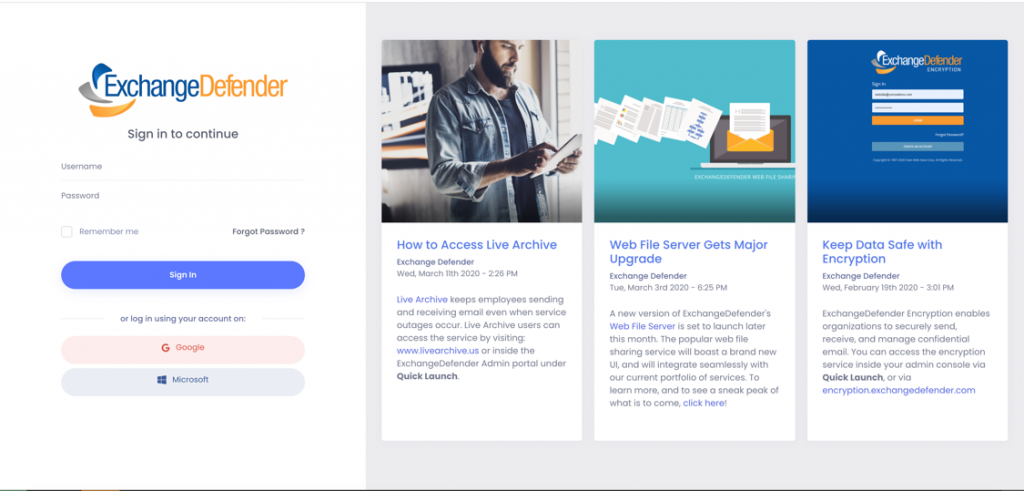ExchangeDefender Advanced Features & Policies
ExchangeDefender is pleased to announce the launch of Advanced Features and Policies, available to all our clients at https://admin.exchangedefender.com. These advanced features are meant to help sophisticated IT personnel establish policies for unique business case scenarios, and better protect their clients from email threats.
Advanced Features & Policies features are available on the Domain Admin section of our administrative portal at https://admin.exchangedefender.com. All features are disabled by default, due to their complexity, and must be enabled by the Domain Admin.

Note about support: ExchangeDefender technical support is available to assist with these features 24/7/365 at https://support.ExchangeDefender.com. We are always happy to help point our clients in the right direction when considering these features. We do not provide troubleshooting or policy analysis for these features, however, as many of these features will by design enable ExchangeDefender to override established IT security best practices. We don’t recommend them, we do not support them, but as always we will attempt to help out and secure the client.
Features at a glance:
Infected Attachments – This policy enables Domain Administrators to allow users direct access to infected or blocked email attachments.
Charset Blocking – This policy enables Domain Administrators to block emails with specific character sets from reaching the Inbox.
Bulk Mailer Policy – This policy enables Domain Administrators to override ExchangeDefender scanning for top 10 mass mailing networks (AmazonSES, MailChimp, Sendgrid, etc)
Display Name Block – This policy enables Domain Administrators to block messages with specific sender names from reaching Inbox.
Secure Web Form – This policy enables ExchangeDefender Encryption clients to receive secure/encrypted messages from third parties.
All of these features were developed with the help of our partners and clients who were experiencing unique issues that ExchangeDefender and other cybersecurity solutions/devices do not address. The hackers are advancing faster than IT can cope and we hope some of these features are as helpful to you as they were to other clients of ours that just needed to “make things work” and ExchangeDefender is always easy to reach.
As we continue to build ExchangeDefender we anticipate to introduce more Advanced Settings that would enable Domain Administrators to build a more powerful security wrapper around their email experience. To get more information about these features please watch our last webinar (available at https://support.ExchangeDefender.com) where our CEO explains the motivation and implementation scenarios.
ExchangeDefender OAuth Support for Google and Microsoft Authenticators
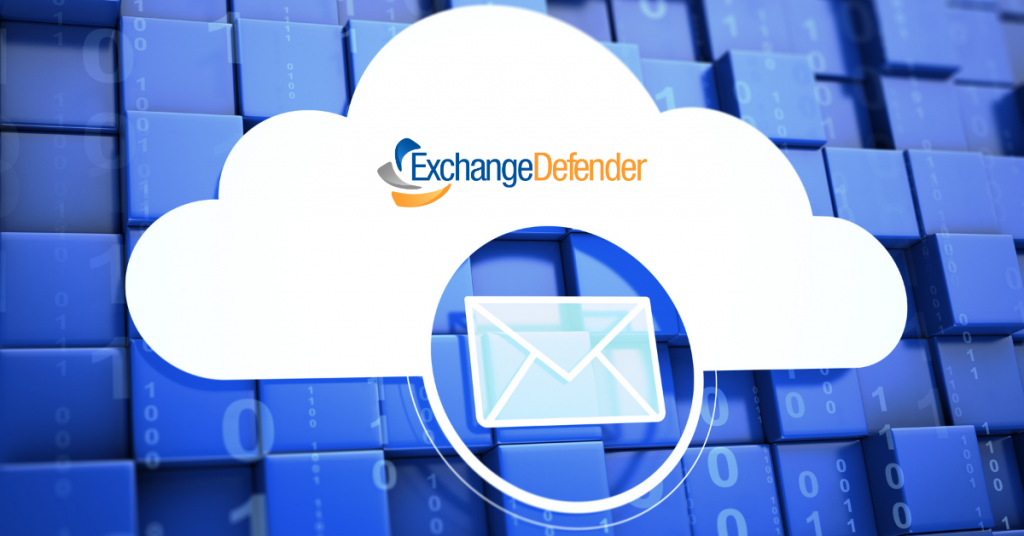
ExchangeDefender is proud to announce the successful rollout of the first phase of our OAUTH implementation across three of our major products: ExchangeDefender Mail Security (Admin Portal), Encryption and WebShare. Originally, our rollout was planned to be a massive shotgun change across all services which would have required users to reset their passwords, but users had to be aware of their current password. In December, we started to log and analyze the entry points users took into the application and found that a majority of users relied on “one-click” login methods like quarantine reports to access their portal and would then jump to other services like Encryption via the “quick links.” Armed with the aggregated analysis, we realized our previous deployment strategy would unfortunately lead to many users being unable to access their services as many users were never aware of their password, thus putting an additional strain on our partners. However, we also know that the current security method was not sustainable for the future.
Enter: Deployment 2.0.
We knew our login system had to be smarter, safer, but also flexible. We knew we needed to rethink a lot of our auxiliary entry points (like quarantine reports) as well as our main entry points to work together in tandem, instead of hard cutovers or independent, one off operations. For example, we needed to continue to allow the legacy password hashing style to be accepted during login, but in-line upgraded to our new hashing algorithm. There were a lot of technical difficulties to overcome as each product maintained its own login page (which many users would save in their browser credential store) and in some instances, had additional security features that do not exist in other products (such as IP restrictions and 2FA in admin, but not encryption or Webshare).
Even more complicated than individual service login logic, some services maintained a list of users who are external entities to the end user’s organization (think Webshare or encryption recipients), and in most cases, these external recipients aren’t in the ExchangeDefender eco system. Ultimately, we decided to allow ExchangeDefender users to continue using each service’s independent login screens for a few weeks before disabling the legacy functionality and hinting to users to click the OAUTH login button “Login with ExchangeDefender” (or even “Login with Google” or “Login with Microsoft” more details below).
Originally, our plan involved redirecting all users to the new login server, which unfortunately would be the Achilles heal of those users who relied on their browser credential store. Ultimately, we landed on a hybrid approach, using the flexibility of using different OAUTH grant styles depending on the application.
The Deployment Timeline
Feb 19th: Activate the new login system for Encryption and Webshare
Feb 21st: Activate the new login system for Admin
Feb 26th: Activate the new centralized navigation headers
Feb 27th: Activate “Login with ExchangeDefender/Google/Microsoft” button to Admin, Encryption and Webshare. Add warning notification to users about the incoming login changes.
Mar 6th: Disable legacy password grant from services, enforce “Login with ExchangeDefender” when a user attempts to login with a username and password on each services page.
Throughout the remaining quarters of 2021, we will continue to integrate the rest of our services into the new login system, including support.ExchangeDefender.com, Compliance Archive, LiveArchive. Time permitted, we also plan on releasing a few tools to improve end user experience such as our Outlook/OWA plugin, built from the ground up to manage quarantine and user whitelists.
New Features to Expect
1 – Integration with Google and Microsoft OAUTH: Users are now able to utilize Google and/or Microsoft as their login provider. Authenticated users will now see buttons to link their Google or Microsoft identity to their ExchangeDefender account. Once linked, users can utilize the “Login with Google” or “Login with Microsoft” buttons instead of inputting their ExchangeDefender credentials to login.
2 – Improved 2FA integration: Users are now able to integrate 2FA applications like Google Authenticator or Authy. To setup 2FA users should login to admin.exchangedefender.com and navigate to the Settings for their account. Please keep in mind that the enforcement of 2FA logins (when enabled by the user) will come with the March 6th deployment. We strongly encourage users to set up 2FA before the full activation of our new login system.
3 – Trusted Devices: Coupled with 2FA, users can elect to mark a device they’re logging in with as a trusted device. Once a device is marked trusted, subsequent logins using the same device will not be prompted for 2FA again for 3 months.
4 – Improved Remember Me: On our login server we improved the remember me functionality to allow users to remain authenticated for 7 days if selected during login.
5 – Login to one, access to all: Users who now login to admin, encryption or webshare will inherently be authenticated to all other services using the new login method. This list will grow as we continue integrating services into the new login system.
6 – Centralized Navigation: Users will see a consistent navigation system across all products utilizing the new login system. More importantly, navigation to other products is streamlined and consistent.
7 – External Integrations: While redesigning the login system, we also elected to start centralizing API endpoints in anticipation of allowing partners and external providers to design their own tools and solutions, backed by ExchangeDefender.
The best antivirus software for small business

There are tons of Antivirus software to choose from and finding the right solution for your business can be complicated. ExchangeDefender can help in assisting SMBs to make the right decision.
What makes a good Antivirus?
Any Anti-virus will do just that, to some degree, that is to fights viruses and other malicious software. Maintaining your personal identification and safeguarding your privacy goes well beyond standard virus protection. SMB’s must understand the difference between an average antivirus protection and outstanding antivirus protection. Don’t rely on just the antivirus that’s built-in to your computer applications.
The difference between good and GREAT
What makes a great Antivirus? A multithread and multi-layered protection approach scanning incoming data. Remember extra, matters – especially if they are within budget.
A few must-haves when selecting Antivirus protection:
- Real-time Protection against viruses, trojans, malware, spyware, and adware.
- Cloud based, User control, Firewall protection
- An Antivirus that works well with others, i.e., MaC, iPhone, and Android
- Attachment blocking and attachment policy management
- Stops identity theft by blocking phishing attempts
This is where ExchangeDefender comes in with our top-selling advanced security suite known as ExchangeDefender PRO. ExchangeDefender possesses enterprise-grade email security suite offering multi-level protection against email-borne attacks. It not only provides exceptional virus protection, but also, phishing, spoofing, attachment blocking, Fraud prevention and so much more.
Our commercial antivirus engines use up to six antivirus engines to scan each incoming message
Cyber attacks continue to rise in 2021
Cyberattacks are here to stay and data breaches are on the rise as we come into the new year, affecting business owners with financial loss, brand damage, and legal ramifications. It is imperative for businesses of all sizes to prevent data breaches. ExchangeDefender’s high Throttled Malware & Trojan Control – has a built-in identification system that tracks the message & attachment MD5 checksums and responds by temporarily delaying messages that match the bulk-mail criteria.
Malware Attachment Filtering & Sanitation is a must – The days of text-only SPAM are long gone. Today SPAM is distributed as a PDF, zip file, image, even an audio file! At the same time, we use our email as more of a file sharing mechanism than a communications platform. Subsequently, it is essential to understand the attachment type and what type of a threat it poses. ExchangeDefender analyzes attachments on multiple layers, using checks for file names, file types, MIME headers and archives to properly protect you from all dangerous content.
From a business perspective, your brand reputation could be on the line, a solid Anti-virus software service would prove essential to protect your company’s, files, systems, and sensitive data.
To learn more about ExchangeDefender’s advanced email security suite,
please click here.
Q4 company updates, and a message from Vlad

ExchangeDefender security solutions experienced a burst in demand that has not let up, and neither has our development output. I’ve been involved in the strategy and our roadmap more than I’ve been in several years and I wanted to give you an informal update on some of our awesome projects and Q4 progress before we turn our attention to 2021. Hopefully we can help you.
Encryption
Encryption has been an undisputed heavyweight champion of sales in 2020 and we’ve heavily invested into the service that is now being used by our clients to secure everything from email stock trade notifications to doctor office sms/txt delivery of lab results. The ability to sell this product a-la-carte without ExchangeDefender (or MX/DNS changes) has significantly expanded our market and reach, while the ability to encrypt and distribute messages via web and sms/txt to mobile devices has opened up the application and use case scenarios exponentially. The demand for the product has not slowed down, and we’re already working on the 3rd update to this service in a year.
The bad news is that due to the demand we’ll stop partner training on December 1st, and Encryption sales will officially stop for 2020 on December 11th (expected to resume in late January 2021). We have a very large enterprise and government presence where most of the contracts, deployment, and projects happen in late December (and with Covid / office / travel restrictions our schedule is already packed).
XD Updates
We are making significant upgrades to our core ExchangeDefender features, and most of them are focused around productivity and management efficiency. For example, we’re starting our ExchangeDefender Outlook/OWA Addin beta later this month. We’re simplifying the way for you to implement and manage DKIM, SPF, and DMARC. We’re launching some other exciting features as an addon pack, which should help many organizations that need better controls to police notifications, confirmations, spear phishing attempts, and full transport rules. Where we’re in highest demand at ExchangeDefender is professional email services, where we’re brought in to assist with a specific email problem. Over the past year we’ve been hired to run mail audits, security audits, insurance company hired us to double-check in house IT, we’ve built several SMS/txt/email gateways, and almost on the hourly basis: security protocol implementations. It’s getting to the point that business email delivery and issue troubleshooting is a full time job. The future of cybersecurity looks bright!
Exchange Essentials
Because business is ultimately about making money, we’ve been pressed to return the Exchange Essentials service. Listen, I understand it, budgets are going to be tougher in 2021 and everyone is going to need an affordable but secure Exchange experience. Even if cuts aren’t crucial, for some organizations it makes sense to spend IT budgets elsewhere other than a $15 mailbox (most people these days spend their time in Outlook on their phone than on the desktop)
We’re bringing Exchange Essentials back at $4.99 for a limited time.
P.S. This is gonna sell out by Christmas, so if you have an opportunity and need us to hold some seats please call us at 877-546-0316, and let us know.
Wrkoo
We decided to give Wrkoo Startup away for free with no limits when we were first looking to shut down our offices in March — we knew small businesses were not prepared for an extended “work from home” and that keeping everyone informed was on every managers mind. We gave Wrkoo away for free to everyone that worked with our partners, everyone that had ExchangeDefender, and aggressively promoted it here in Orlando because we wanted to help our community. We are truly all in this together because small businesses depend on each other. This is a rather expensive marketing write-off, but we’ve pledged to keep it free through at least one quarter after the USA gets vaccines.
Through this time we’ve heard from people who are using Wrkoo to provide customer service, to send out invoices, to track time, to manage entire projects, we have a translation service that runs on it, and a business vertical of every kind. And with ExchangeDefender we keep on connecting business productivity with the way people actually work and communicate when they need to get stuff done. We couldn’t be happier to have been a part in someone getting their business together in the cloud. Throughout all this mess, Wrkoo is the way we keep everyone accountable and on the same page. I know it can do the same for your business, or recommend it to a friend.
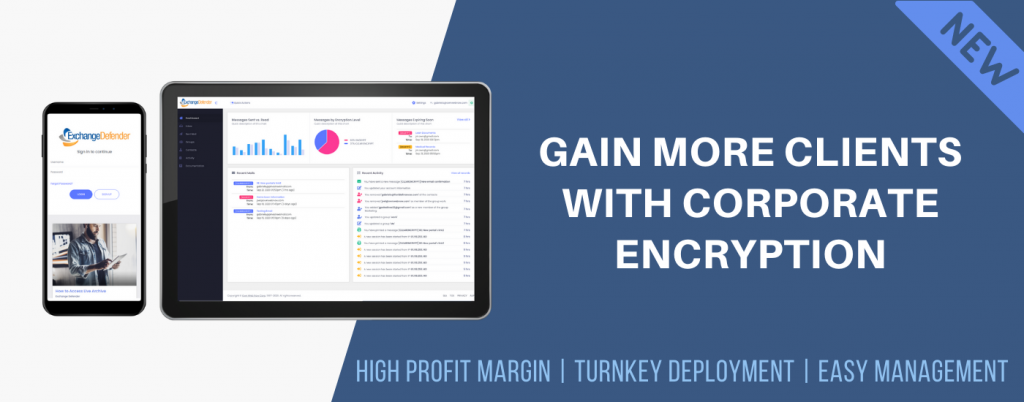
Corporate Encryption Upgrade – What Did We Change?
The restructure of the encryption portal was driven solely to enhance the user experience. The ExchangeDefender Encryption Portal gives users central access to all encryption messages, contacts, advanced encryption options groups, SMS, URL as well as a full audit log. All available from a secure site, available via desktop and mobile.
Let’s take a look at what’s new:

For Contacts, we have made it easy to be more productive by saving contacts you often send messages to.
Click, Create New Contact and provide the name and email address. It is that simple.
Basic vs. High Security
Primarily High Security requires the recipient to create a profile to ensure the message is not compromised by a 3rd party. We strongly encourage the use of High Security. Basic Security also provides end-to-end encryption, but does not require the recipient to register with ExchangeDefender.
Advanced Options are located on the right hand side of your screen, these features were created to enhance the user experience and to offer more flexibility for the user.
- Automatically destroy the message after # days.
- Notify this user when the recipient reads this message
- Password protect this message
- Notify me when the recipient reads this message
- Actions allowed for recipients: Allow Reply/Forward or to Print
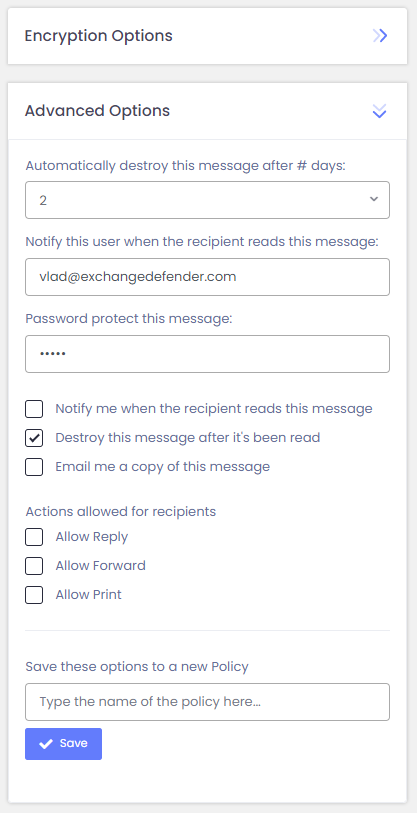
Groups
ExchangeDefender Encryption also supports groups. You can add contacts to a group by clicking on +Create New Group and providing information about your contacts. At any time, you can also click on the + icon next to the group name to +Add more members or click on the red X button to remove from the group.

Send encrypted messages via URL (Website)
ExchangeDefender Encryption enables you to send encrypted messages to web sites and services while maintaining the security and custody of the message contents.
The system generates a short URL that can be copied and pasted into Slack, Teams, Facebook, social media, or any other web site. URL Encrypted Messages are the most popular features as it provides a secure authentication layer, automatically deletes contents, and provides tracking. Simply type your subject, message, attach documents and click Send and a dialog box will pop up with the link to the message. You can copy and paste this link and everyone with the access to it.

Send encrypted messages via SMS
Send encrypted messages to mobile devices via SMS / text messages. This feature is highly sought after by doctors, attorneys and insurance personnel that are frequently interacting with clients that are on the move. “We’ll just text it to you” is an easy way to deliver a secure message via the recipient’s mobile phone number.
The recipient receives an SMS message with a link to the secure encrypted message. They will click the link, the default web browser on the phone will go to the secure SSL-encrypted web site to show message contents.

Internationalization
ExchangeDefender encryption portal has adopted Internationalization by designing the portal to be adaptive to various regions without engineering changes.

Audit Log
Every action related to encryption is listed here and reflects what was done even after the messages are gone.
To learn more about ExchangeDefender Corporate Encryption, click here.
ExchangeDefender Whitelist vs. DEA (Disposable Email Addresses)
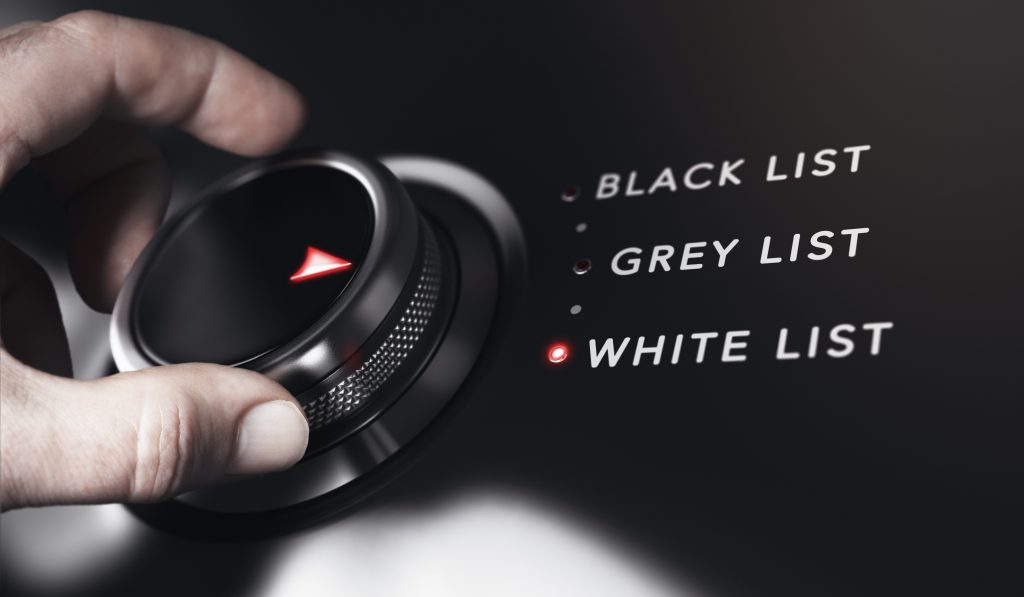
ExchangeDefender is a cloud-based email firewall, and as such we enforce client’s policies against the only email address that is trustworthy: the envelope from address.
Over the past few years there has been a significant increase in use of disposable email addresses (DEA), specifically among mass/bulk mailing operations such as SendGrid, AmazonSES, MailJet, SMTP2Go, SocketLabs, Postmark, Mandrill, Mailgun, MailChimp, ConstantContact, etc. These email addresses, also known as “dark mail” create a unique email address to serve as the official From: line, in an effort to track bounces and delivery problems. Every time you get an email from one of these mass mailing operations the address the message actually came from is unique and generated just for that email/campaign – so whitelisting/blacklisting such addresses can be a challenge for clients that do not use ExchangeDefender’s admin portal or quarantine reports (which detect BATS/DEA addresses and auto-suggest the domain or IP to create a policy).
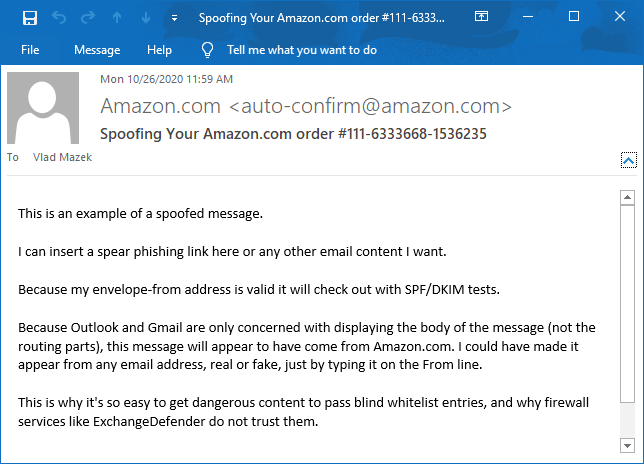
Bulk mail operations are not just used for mass marketing mail, where companies large and small do not want to build out the infrastructure to deliver tons of email. They are used for notifications, alerts, and most legitimate junk mail that you get. Unfortunately, the same companies are abused in virtually the same way by hackers to deliver spear phishing content. Because the body/header From: address can be easily faked, hackers hide behind places such as SendGrid, AmazonSES. Because they are highly automated, there is relatively little in the way of policing on these networks: after all, they make money to deliver junk mail to you and have little incentive to keep SPAM and phishing content from being sent through their networks.
Over the years, we’ve taught countless MSPs and IT people the difference between the “envelope from” (routing address) and “header or body from” (fake, but friendly looking From address displayed in your email software like Gmail or Outlook). As our client base has changed over the years, we’ve decided to write up an intro-level explanation of the process and how to master it. You can find it here:
https://www.exchangedefender.com/docs/whitelist
We hope you can use it to better block or permit access to these operations. If you’d like our assistance with this process, please open a ticket at https://support.ExchangeDefender.com and remember to attach the .eml file and/or full headers which are required for troubleshooting.
For our pro subscribers, stay tuned. We’ve been hard at work on our antispam engine enhancements and we’ll have a friendlier way to manage this by Thanksgiving 2020.
Corporate Encryption: How to compose an encrypted message
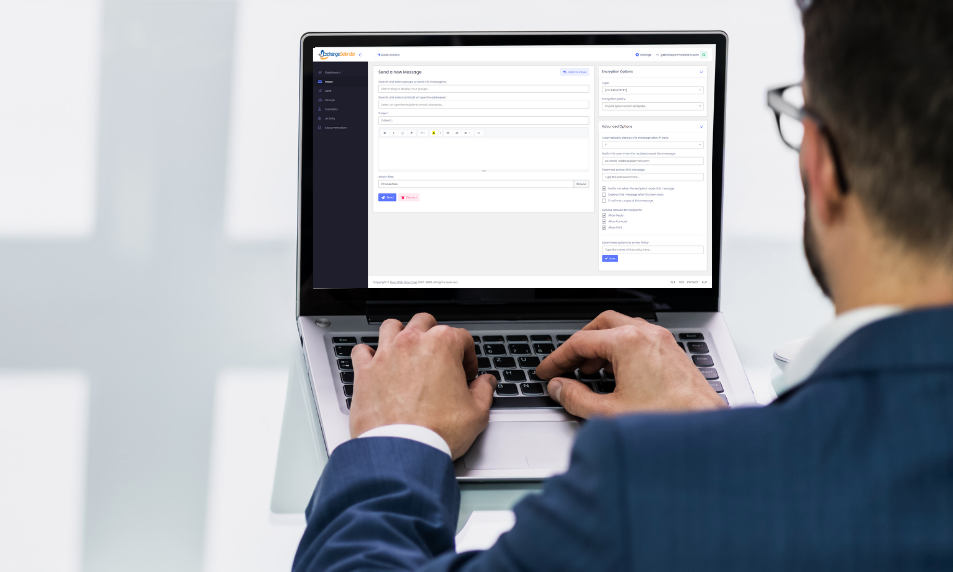
Our new user-friendly interface makes sending and receiving encrypted messages a breeze. The redesign really focused on the end user, and how the software would be used on a daily basis. We made sure to include flexible options to be able to securely share sensitive information to a Contact, or a group of Contacts all at once.
Option 1: Sending an encrypted message by email
There are a few ways to send an encrypted message with ExchangeDefender. The first being the traditional way – typing in the email dress of your recipient, adding the subject of the message, along with any attachments, and clicking Send.
From your Dashboard, the steps would look like this: Inbox > Compose email button > New Message.

Option 2: Sending an encrypted message by URL
The second option in sending encrypted messages is highly customizable which includes the ability to send secure message by URL, or by text message. As of right now, ExchangeDefender offers the only omnichannel solution for message encryption allowing you to send messages securely to web services as well as mobile devices via SMS.

ExchangeDefender Encryption enables you to send encrypted messages to web sites and services while maintaining top security of your sensitive information.
How does it work?
The system generates a short URL that can be copied and pasted into Slack, Teams, Facebook, social media, or any other web site or service. URL Encrypted Messages are among the most popular features of ExchangeDefender Encryption because it provides a secure authentication layer, automatically deletes the content, and provides advanced tracking.
How do you generate the shareable secure link?
The process is exactly the same as sending a message to an email address, group, or mobile device. First, be sure to select the URL button, then type your subject, message, add an attachment (optional) and click Send.
Once you click the Send button, a pop-up form will appear with the link to your secure message. You can copy and paste this link to the contacts whom you wish to have access.

Option 3: Sending an encrypted message by SMS Message
“We’ll just text it to you” is an easy way to deliver a secure message while still keeping the contents in your custody in your secure Inbox. ExchangeDefender Encryption enables you to send encrypted messages to mobile devices via SMS / text messages.
Sending a secure message to the mobile device is same as sending any other encrypted message through ExchangeDefender encryption – with one important difference – you only need to know the recipients mobile phone number.

Simply, tap the Compose
Email button, then select SMS tab to create an encrypted message with
SMS delivery.
The recipient will receive an SMS message with the link to the secure encrypted
message. When they click on it, the default web browser on the phone will go to
the secure SSL-encrypted web site and show them the message and contents.
Please note: SMS messages and URL messages only support Basic Security encryption because they are not sent to an email address that could be used as a login. Please make sure that you enforce tight expiration window, and please setup a password to minimize the chance of unauthorized access.

ExchangeDefender Corporate Encryption – SMS & Secure Texting Feature
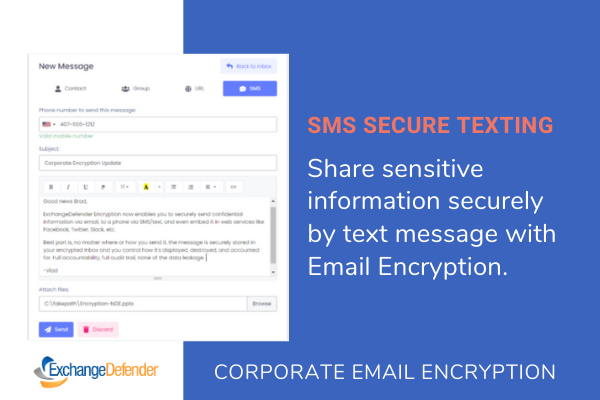
We recently won a very large financial institution contract with our ExchangeDefender Corporate Encryption by solving a not-so-unique problem many businesses have with their encryption solution:
“It’s a disaster. I spend more time resending encrypted messages or walking clients through how to access forms than I do on actual processing.”
This is what we heard over and over – email encryption solutions are ugly, not intuitive, not very user friendly, and half the time they get lost somewhere along the way. If your business has a loan officer doing email support, your email encryption is not working for your business.
“Sometimes we just text them parts of it blurred out so we can move ahead until they come into our branch.”
What if you could text them, but securely?

Mobile phones have become so ubiquitous that they are already being used a secondary security credential (via 2 factor authentication or OTP) – and now ExchangeDefender enables you to rely on them to securely grant access to confidential or sensitive information
ExchangeDefender makes this easy by allowing you to simply send anything you need to handle securely to your clients phone via SMS/text. And to do so while being even more secure than with email. Unlike email, that multiple people (from admin to IT) have access to, only you have access to your phone. Nobody else, with your credentials, can snoop on that. So compose a message, type in a phone number and send them the link to the document and attachments securely.
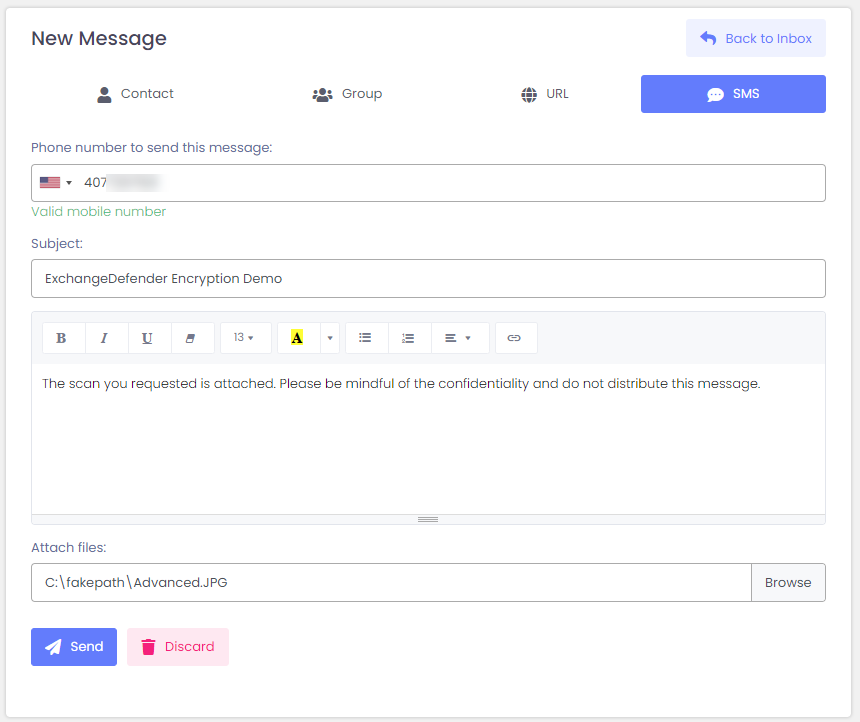
But ExchangeDefender Corporate Security makes that even better and more safe. First, you can password protect the message and either give them in a call or using other means. You can even make sure that they cannot share it or that it would get compromised later – just set the message to expire after it’s been viewed.
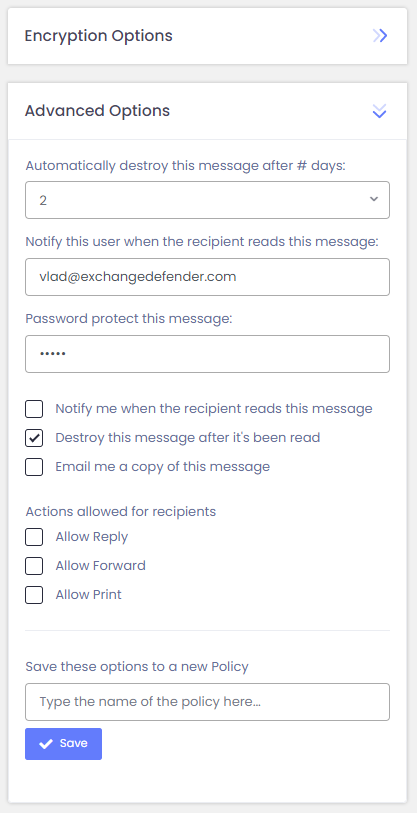
And of course you will be alerted when they actually click on the link and access your message.

You can even track it.
ExchangeDefender Corporate Encryption is truly enabling multi-platform secure sharing of secret, sensitive, and personally identifiable information. With our SMS/text feature, you can now reach people on their mobile devices and get them secure access to the information without an app or without dealing with their email issues. Best of all, your message never leaves you, the clients only get the link – so if you made a mistake, you can revoke and destroy the message immediately.
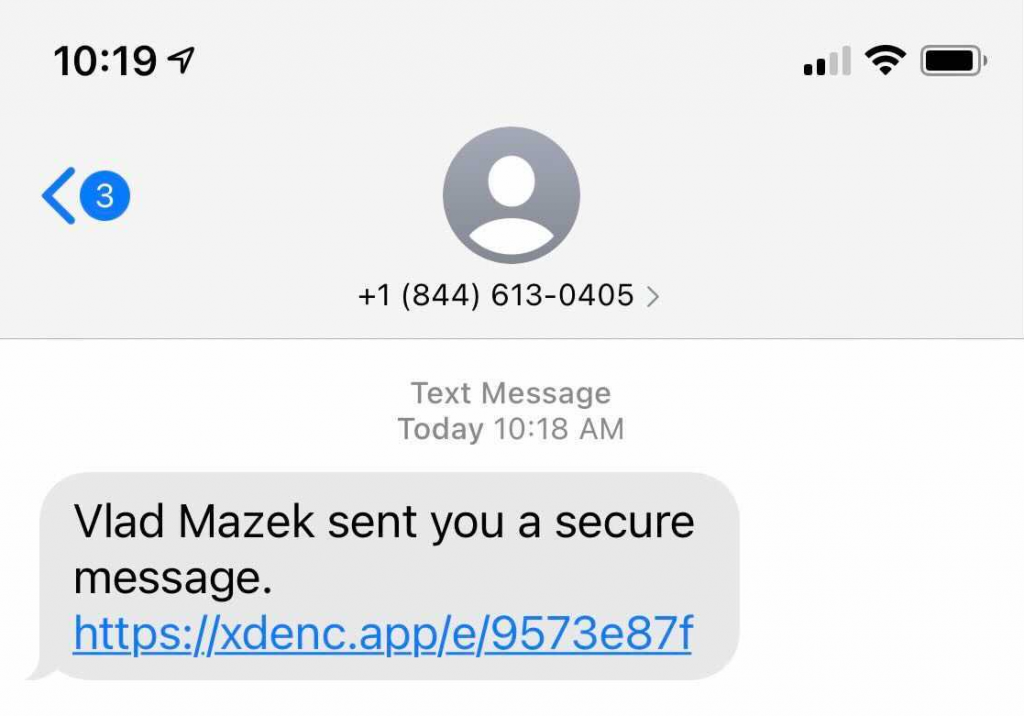
This level of secure messaging and audit trail is unprecedented – and now you can say “I’ll just text it to you, but securely. Password is encryption and it will auto-destroy after you pick it up.”
ExchangeDefender “Certified Letter” Encryption Highlight
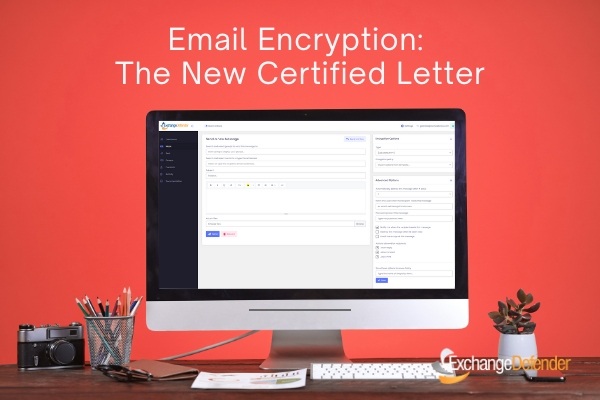
ExchangeDefender recently launched our second update for 2020 Corporate Encryption, and the feature that caught the most attention from our partners was the ability to send and control sensitive content via URL (i.e. web):
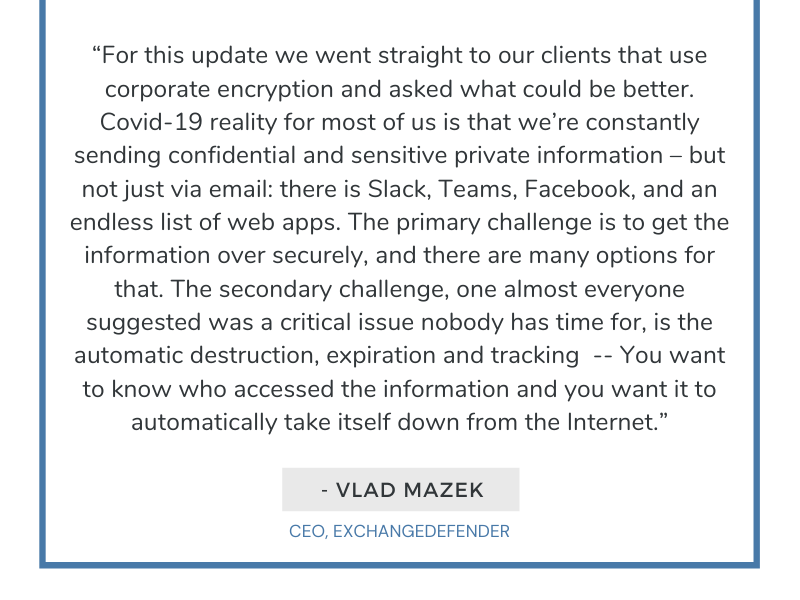
At ExchangeDefender, we simply call this Certified Delivery. When you absolutely, positively, totally must get the information to the third party securely – know who, where, and when accessed it – and that it will automatically expire/destroy the contents so you don’t have to track it or worry.
How to securely share info on the web
As a subscriber to ExchangeDefender Corporate Encryption, you have access to our encryption portal at https://encryption.exchangedefender.com. You can even bookmark this shortcut so you can quickly send messages straight from your browser.
Once there, click on Quick Actions > Compose Mail. Select URL.

Type up your recipient’s name, subject, message, and attach any attachments you may want. After you click on Send you will see the following popup:

That is it. Your secure link is generated and you can paste it anywhere you want. It is as simple and as fast as that.
But suppose you wanted to get some more control over the message and our automated policy enforcement. Click on Advanced Options:

This is where the power of ExchangeDefender really shines as it integrates into the client’s unique business requirements, which may vary depending on the information, recipient, and sensitivity.
For example, I am going to be sharing a secure message with an attachment that is time sensitive. I am setting it to automatically delete itself after 2 days, meaning I don’t have to come back and delete it myself. I also want to make sure that this message gets destroyed as soon as the person I sent it to views it – that way I minimize the likelihood that whoever is snooping on their computer / phone can get the same data. And because I am not actually sending any data to their PC, I have full control – meaning I can revoke/delete this message before they get to it too. I am also adding a secondary password to this message that I will communicate separately. For extra piece of mind, I am also asking Corporate Encryption to send me an email when someone picks up this sensitive message.
But wait, there is more
Sharing sensitive information comes with responsibility to keep the system accountable – you want to know if they got the message, when they got the message, where they accessed it from, and ultimately what they did with it. So ExchangeDefender Corporate Encryption offers you a variety of ways to do this easily. The best option is the Activity tab in the Encryption Portal:

Here you can track down the activity for each message you send, export the data for analysis, or just save it for your records. There is even a weekly email report if you don’t want to get flooded by email notifications when you share info with multiple people that might be accessing it frequently. ExchangeDefender Corporate Encryption brings several additional layers of information control and accountability. It actively works to keep you, and your information, more secure. And we’re thrilled to be able to save our clients time on tasks they do every day – to see more of what our clients asked us to build, take a look at the webinar recording!
Email Encryption: New Security, Productivity, and Advanced Reporting Features Released
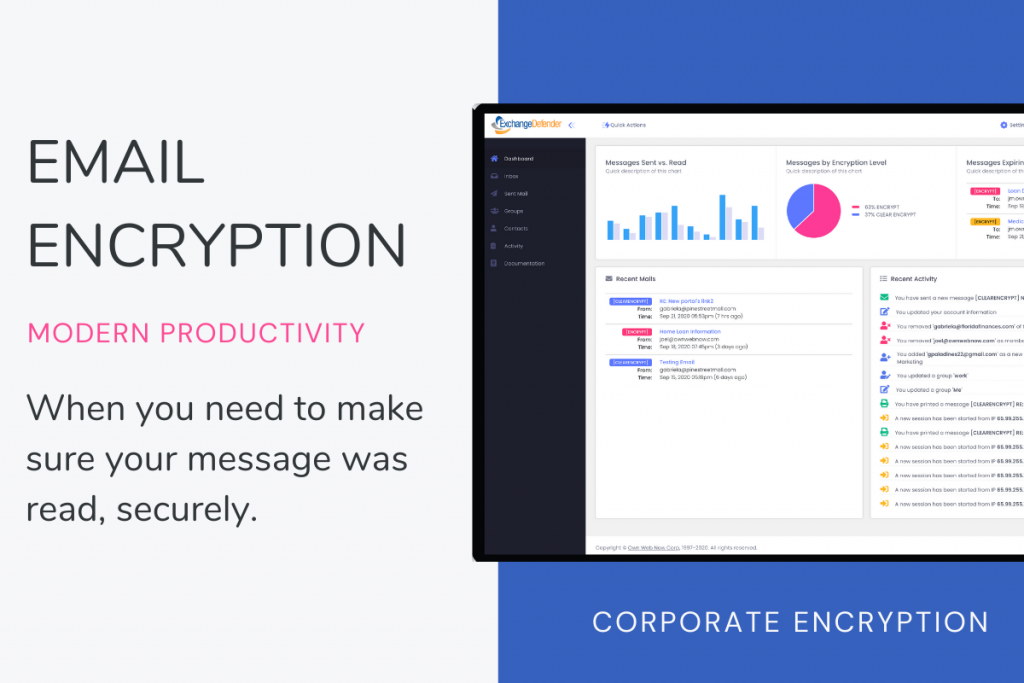
ExchangeDefender Email Encryption: When you need to make sure your message was read, securely.
ExchangeDefender is proud to announce the launch of a new version of ExchangeDefender Email Encryption, our second update to this service in 2020 built entirely from user feedback.
Covid-19 pandemic has permanently changed how we exchange secure documents with people outside of our organization. In 2020, encrypted email has become a standard for secure delivery of confidential information. When you absolutely needed to make sure your documents got delivered and received, you’d turn to a fax machine or certified mail – but in 2020 with remote work and reducing touch or even office – we’re turning to Email Encryption. It’s no surprise that Email Encryption is now our most popular service.
For this new release, we went back to our users with a question: How can we make you more productive?
Encrypted Email is the modern version of a certified letter
When you have sensitive information that you need to make sure stays confidential, email encryption is your go-to solution. In fact, the biggest complaint about email encryption is usually about how clunky and user unfriendly it is. This is because email encryption was not designed with a sender or recipient in mind, but the IT and Corporate Compliance Officer staff that needed to protect ordinary email flow and keep any sensitive information from leaking out.
We wanted to solve this problem so we focused the new version on productivity.
This meant spending more time perfecting the user experience, both for the person in charge of sending sensitive information and making sure that the recipient can easily and safely access the message. With no training, no obstacles, no software installation, and accessibility anywhere, anytime.
Almost all of the corporate effort in email encryption is focused on acronyms and alphabet soup of regulatory requirements that are largely automated. But the real opportunity – and our clients identified obvious pain points – is in the day-to-day use of the email encryption system to send confidential information and make sure it’s received.
Sending Encrypted Messages
Our biggest goal was to make sure everyone could send encrypted messages without a ton of effort – so we’ve made it possible to subscribe to Corporate Encryption without subscribing to ExchangeDefender at all. Yes, it’s available a la carte and you just need to sign up (no MX record changes, no hosting provider changes, just sign in to the encryption portal and click Send).
For our clients that live in Microsoft Outlook or Outlook Web App, we’ve made it even simpler with the ExchangeDefender Encrypted Email addin. Now email encryption is just one click away.
Our biggest challenge was to make encryption easy to use – with so many powerful features and settings, modern email encryption solutions feel like an airplane cockpit to many white collar workers. We started by simplifying the user interface and giving IT/Compliance Officers the ability to create default organization policies – so users only need to worry about the message and where it’s going. All the advanced options are just a click away, enabling users to tweak email encryption to meet any unique business task.
So we’ve made it easier to obtain, easier to get started, and beyond effortless to use!
Controlling & Automating Encryption
We did not forget about our power users and our new release has all the features our clients have requested. Advanced Options no longer clutter the screen, but they are only a click away.
Once you customize the policy for a new message you have the option of saving it as a new policy and simply reusing it later (instead of always going through all the settings).
Regardless of the industry or the role we spoke to, our clients stressed that one-size-fits-all approach simply doesn’t work. While all appreciate and understand that there is a security policy requiring encryption of sensitive data, the pain point for everyone is the notification system: We all have to comply with the encryption policy, but we’d all like more flexibility with how we’re notified about our encrypted messages. Simply put, it can depend on the content, the urgency, the concern for how the message is shared with 3rd parties, and even on who is being contacted. As one office manager told us:
“When I’m sending a letter to our attorney or CPA, I need to know the moment they got it. But when I send out 300+ lab reports, I really don’t want to get 600 notification emails. I wish I could manage how chatty the service is for each situation”
Now you can – just save the new policy and reuse it as often as needed.
Important thing is, everyone stays secure using the default organizational encryption policy. New users don’t need to be trained or taught every single setting, they can just rely on the corporate policy that assures they don’t make mistakes.
Tracking Encrypted Messages
One of the biggest additions to Corporate Encryption is the Activity Report. As our users consistently put it: “Encryption is half about protecting the content and half about making sure it got to the recipient”
Tracking receipt of messages using encryption solutions is generally about searching through tons of email notifications: finding a specific message and what happened to it is an analytical process. We fixed that, for power users and occasional users alike.
If you’re constantly sending encryption messages, tracking them becomes simple using our encryption portal that is accessible from any PC or mobile device. Simply login at https://encryption.exchangedefender.com (branded URLs coming soon) and click on the Activity tab. Here you can locate a specific message and see every activity related to it.
If you’re after a report, you can also use our powerful filtering to select the right action, date range, and contents – then just export it to PDF, Excel, CSV or just print out the web page and you’re done.
If you are not a power user, but send a lot of encrypted messages, we’re making your life simpler as well. Instead of getting an email every time something happens, you will now get a weekly email report showing you all of the messages you sent and what got delivered, read, printed, forwarded, etc.
Simple. Encrypted. Reported.
ExchangeDefender’s new Corporate Encryption is all about giving organizations better control over their sensitive information. For many business purposes surrounding security and data leakage, ExchangeDefender’s powerful encryption policies, lexicons, pattern recognition, and support for hundreds of regulatory standards will help keep you safe.
ExchangeDefender is about more than just safe, we’re about safety and productivity. Our new UI will make sending confidential information faster and simpler. Our new policies will make custom notification templates and message control effortless. Our ability to make an encryption platform that fits the way you run your business, be it email or a shared URL or even an SMS message — that future is now.


